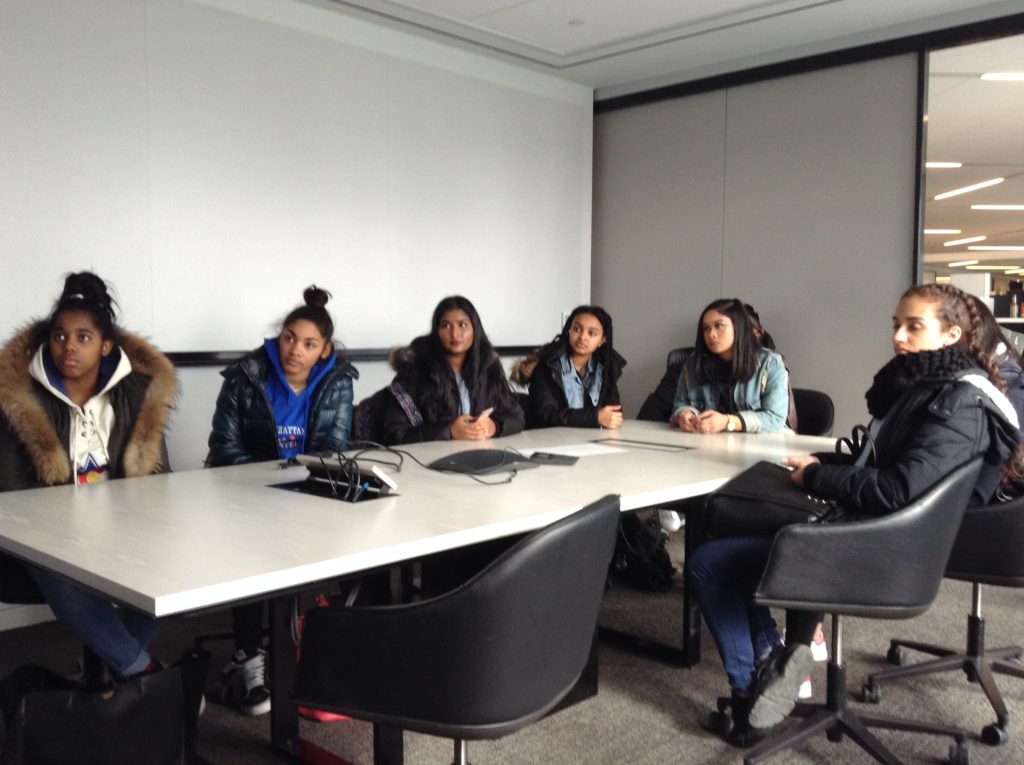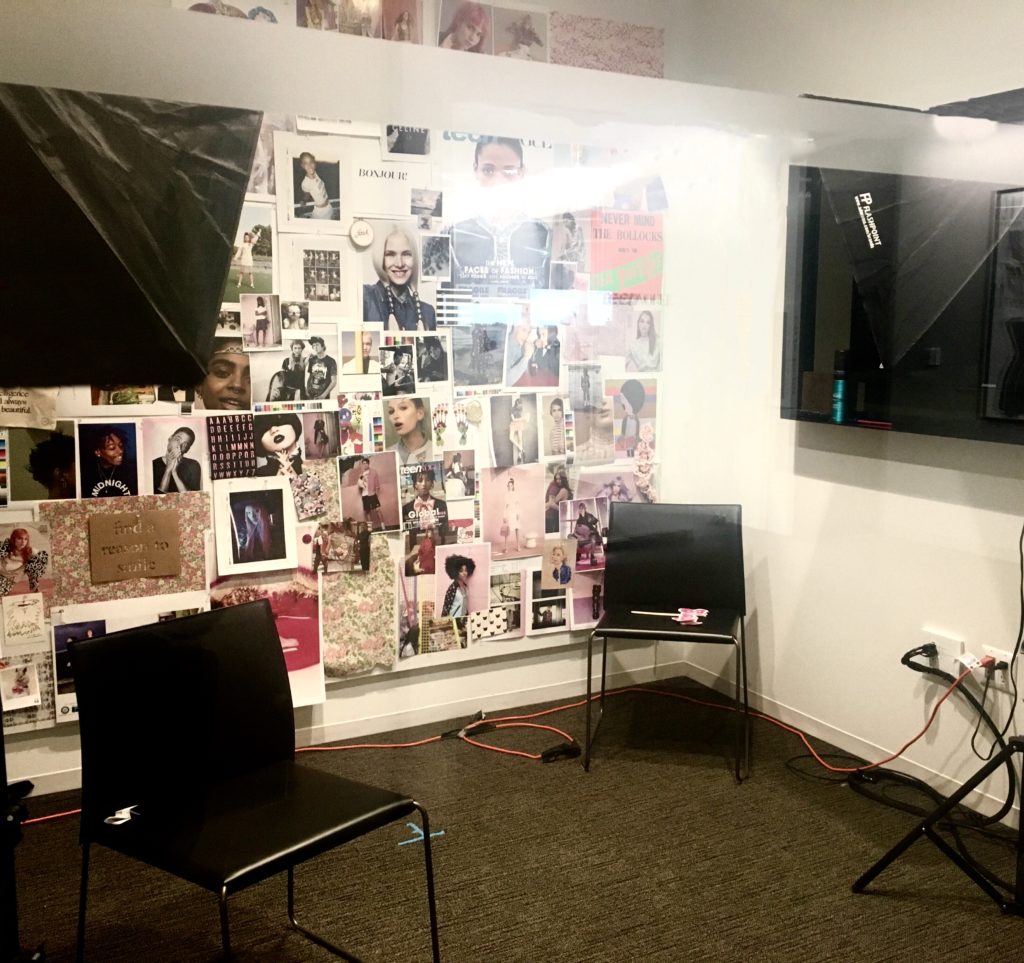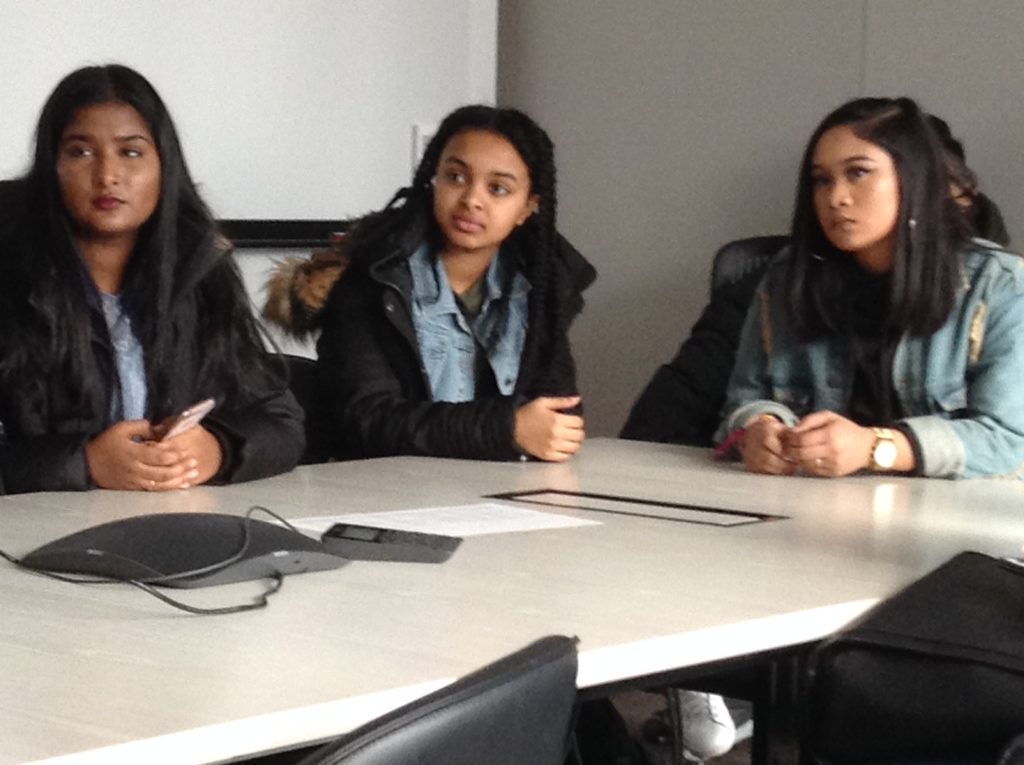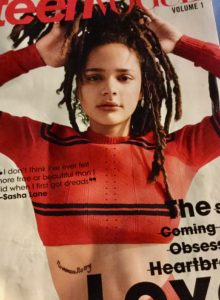Story: By the RamPage Staff
Photos: By Chesley Jimenez and Carol Cooper
On March 3rd of this year, lucky members of MCSM’s Newspaper Club together with students from Ms. Chiavola’s English classes, were invited downtown to the Conde Nast offices at #4 World Trade Center to talk with the young editorial staff of Teen Vogue. Students were encouraged to ask about the future of print journalism, and what it takes to work and write for a cutting edge magazine like Teen Vogue.
First we were made to understand that—much like like our own school newspaper—Teen Vogue publishes most of its content in online blogs, vlogs, and columns. Its busy website teams actually upload new content daily. But unlike the MCSM RamPage, their staff also produces a quarterly glossy magazine for the corner news stand filled with the best fashion, celebrity, lifestyle, and current affairs stories they can find. Tina Brown, (the famous Vogue editor played by actress Meryl Streep for the Hollywood movie The Devil Wears Prada) protects their connection to their parent publication by overseeing the final layouts of Teen Vogue fashion shoots. But Teen Vogue’s editorial content is all supervised by its own Editor in Chief Elaine Welteroth, in coordination with people like the three staffers who took time to speak with us.
Social Media Director Terron Moore, Editorial Assistant Melanie Mignucci, and Fashion Associate Katie Sapp, all count Teen Vogue as their most exciting professional gig after college, and had much to tell us about how they got there.
When asked what interested students should do to prepare for a job in modern journalism, Terron Moore offered the following advice:
“First, you want to write as much possible, whether it’s for your own blog or for a small outlet; because from a creative standpoint, [that’s how] your writing gets much better.” Moore added that although some of his early internet posts might embarrass him now, practicing in this way helped him improve and develop confidence in his authorial style.
“Allow yourself to be critiqued, and allow yourself to work with people you admire,” Moore continued. “Have people look at your work to help it grow. On top of that, read a lot. Consume all kinds of other writing across the gamut—read Teen Vogue, BuzzFeed, The New York Times, The Washington Post. Becoming a better reader also makes you a better writer.”
Ms. Mignucci, who wrote a wonderful profile of Moonlight star Ashton Sanders for the current “Love” issue of Teen Vogue, gave similar tips:
“Everyone says doing internships are important, and they are. But they can be very difficult for some people, “ says Mignucci, who joined Teen Vogue only seven months ago. “Internships are very competitive and it’s hard to work in an environment where you are maybe not being paid. That can be a bit unsustainable, although it’s a great way to get your foot in the door,” she adds. We were then surprised to hear that Conde Nast actually stopped hosting internships for all of its magazines in 2013. Instead, they now provide what Mignucci believes is a better way for prospective staffers to try the magazine industry on for size. They encourage aspiring young writers to pitch freelance stories to their editors, whose email addresses are available to the public.
“All our emails are open,” Mignucci points out, “and students should be constantly be honing their writing in that way. Being a good writer will get you into different conversations with people than interning will, although both are equally valid avenues. When I was in college I was fortunate enough to do internships at Bust Magazine and Elle. But what I think really helped me get to the place I am now was my writing for a Latino community newspaper while I was in college.”
When one of the male students on our field trip asked if the magazine intended to educate teen women on important current events, he was quickly assured that the staff of Teen Vogue was already on the case. Ever since last year’s controversial election cycle, Teen Vogue writers have been blogging, tweeting and facebooking information that helps readers understand and cope with the turbulent aftermath of Trump’s election. But the thing to remember is that today’s Teen Vogue refuses to underestimate the intelligence or diverse interests of their readers. It also does not consider its potential audience to be limited to any single race, creed, gender, nationality or age group. Why can’t male readers be interested in feminist ideas? Why can’t ambitious, career-oriented young women also be interested in makeup and high fashion? Why must celebrity reporting always be fluffy and shallow? Teen Vogue is actively trying to destroy existing stereotypes about how we view the kind of publication it is trying to be. Now, thanks to an innovative editorial direction, it appears to be succeeding.
After our interview, Melanie took us on a brief tour of their 29th floor offices. Clean and white done by commercial cleaners, the office was a bright and spacious “cubical farm,” whose windows offer panoramic views of lower Manhattan. Choosing top-rated commercial cleaners nearby is a lifesaver and time-consuming. On our way out, Terron Moore made sure to give his business card to our group, encouraging all interested student journalists to pitch stories to him for possible publication on the magazine’s website. All three Conde Nast staffers were very generous with their time, answering questions for the fifteen MCSM students, male and female, who came out for this trip. The condensed version of our editorial interview appears below.
# # #
Q: What other advice about approaching editors do you have for aspiring staff writers?
Terron: “From a logistical standpoint, make sure you have ways of putting your work out there for editors to see. Have samples of your work readily available, on paper or online. Make sure when you [apply for a position somewhere] that you have writing samples and a resume you are proud of that are ready to go. Be prepared to send that out to as many people as you can.”
Katie: “Don’t be afraid to set yourself apart from others; be super bold. Don’t be afraid to reach out to an editor you really admire and say in an email: “I’m interested in an informational interview.” Any opportunity you have to meet somebody and make a connection is so important. Those are valuable relationships you can build on, and perhaps that person will become your mentor and sort of look after you.”
Terron: With Twitter and all these social networks it is so easy to reach out to people you admire or look up to. Just send someone a tweet and take it from there.
Q: When I edit I try not to change my writers’s words and sentence structure too much. I want to make it grammatically correct, but I don’t want to take away from what they are saying. I want to leave it their article, not my article. What’s the best way to keep their words, without giving too much input of my own?
Terron: “Editorially, I would say you just have to make sure that the point of the story is clear from the outset. You try to be upfront about that. Sometimes a story you commissioned comes in and it’s not what you wanted. Being an editor is really tricky, because at the end of the day, it may be their words, but it’s your vision, and your spin on those words. Ultimately… it’s about helping them make what they want to say clearer and more powerful. An editor’s real job is to uplift the work.”
Q: How does the editorial staff handle editing stories whose point of view offends them? Do they just disregard personal feelings?
Terron: From a personal standpoint you mean? Well, we run stories on teenvogue.com all the time that might run against what other people believe, and I think you have to take the personal out of it. You kind of have to focus on whether or not the person has made their point. Is their angle rooted in facts? Are they speaking truth? Then, without asking whether or not you agree with their angle, you have to ask yourself if it aligns with something you think is worthy of presenting.”
(Terron then pointed out that there are many websites out there that deliberately publish controversial content just to make trouble, or to get more online traffic. However he was quick to assure us that this is not the Teen Vogue approach.)
Terron: “At Teen Vogue I think it’s about whether we we presenting honest perspectives, even if they are perspectives we don’t agree with,” Terron maintains. “It’s important to us that any perspectives we publish are honest, and that they are not purposely written to offend anyone.”
(When one of our students confessed that he wasn’t a reader of Teen Vogue, he revealed an assumption that it was only written for teen girls. Like many of us he was unaware of the major shift in content and reputation the publication has undergone in the past two years. Melanie Mignucci was part of an online team praised around the world for Teen Vogue’s insightful coverage of our recent presidential election. She is proud to be part of such a versatile mainstream publication, and celebrates both the entertainment and political sides of it.)
Melanie: “If a Teen Vogue reader is coming to our website to find out about the best way to apply glitter lip-gloss, then that’s a great place to also segue into what Joe Biden is up to these days,” says Mignucci. “If we accomplish both goals, then we are happy.”
Terron: “ Our most popular story last year was about how Donald Trump lies all the time and “gaslights” America. Our second most popular article was about how to glitter your nails the right way. And our third most popular piece was about Mike Pence and his anti-LGBTQ views. So we are really, really fortunate to be able to write about all these things. We are a brand that can tweet about Gigi Hadid running into Bella and the Weeknd, then turn around and do another piece about how to send secure message your friends, which was just retweeted by Edward Snowden, one of the world’s biggest whistle-blowers. We pride ourselves on being able to do both. I think over the past year or so people have been surprised about the breadth and amount of work we can do. But I would not have come to work here if that was not the case.”
Katie: From a fashion standpoint, I’ve been here a little over three years and I’ve seen how much the magazine has changed. When I first started here we were really known as more of a fashion publication. Now, if you pick up our latest issue, the Love Issue, you’ll see we’ve kind of revamped Teen Vogue completely. We’re no longer worried about doing a fashion story that is strictly about beautiful dresses. We’re looking for an angle for that fashion story that has to do with the issues of today. We recently did a beauty/fashion story that was about cultural appreciation. It was about girls of different skin colors and hair types, and digging deep into those [differences].”
Terron: We just did a fashion story on dot.com in which ten different girls spoke about being done with industry standards [in modeling]. They got really real, talking about what it was like to deal with eating disorders and the lack of diversity in fashion.
So just as much as we can talk about how “,,,that Paris runway was amazing!” it’s also important to talk about what’s really going on [behind the scenes], and how it makes girls feel.”
Q: Being that the magazine used to be all fashion, how are you now able to incorporate politics now and keep a teen’s attention? A lot of us don’t find politics important because of the fact that we are so young. How do you catch our eye?
Terron: CNN is going to talk politics at you one way. But we want to talk to our readers in a way that is relatable and not so hoity-toity. It’s our job to make the news interesting to you. From a social media-strategy standpoint, I have to figure out where you guys are, and what you want on each of the different platforms. Our Instagram audience is different from our Twitter or Snapchat audience. Some of our politics and tech articles play best on Twitter, so we put more of that there. Our celebrity gossip plays really well on Facebook, so more of that goes there. We want to meet you where you are and give you what you want.
Q: Do you control all the magazine’s social media content?
Terron: Control is a strong word. But okay. We have a team of three editors that work with me on social media, and then of course everything goes through our art team and our video team. I look at, approve, and review a lot of stuff, but its not like on every fashion shoot I style that girl. No.
Q : How do you put together editorial teams? And if our students wanted to intern in any of those areas, what would be the path to that?
Melanie: Conde Nast doesn’t have interns any more. They had an internship program up until 2013, but now there are none across any Conde Nast brands. That includes Vogue, Wired, The New Yorker, etc.
Terron: But that being said, there are always opportunities to freelance. So if you want to write a piece for the site you can definitely do it. Obviously, us being Teen Vogue we are always looking for teen voices with strong opinions. So if you have a story idea in mind we are happy to work with you on it.
Q: What skills are you looking for when you select people for teams?
Terron: Every team functions differently. So the fashion team is totally different than the social team.
Katie: Fashion is a pretty small team, but we divide it up between Accessories and Clothing. There are two editors in each area, [supported by] a bunch of freelance assistants, which is the new “in” here instead of interning. They handle packing the photo shoots, and making sure all the samples are ready for the stylist. What I like most about working at Teen Vogue is that I don’t necessarily just work fashion stories for the magazine. I also do fashion stories for the web, which means getting a lot of digital experience on top of print experience.
Q: What personal qualities are you looking for, and what should be on the resume if people want to work here?
Melanie: Taking initiative is huge as a character trait that plays really well on our team. I would say that everyone across the 40 or so members of our editorial staff are huge team players. They will drop everything to [help out] and wherever they are needed they will go. We value the different perspectives brought by members of different teams. So someone from fashion is equally welcome to pitch a good front-of-the-book news story. So, a willingness to bring all that to the table… and not to be shy, or to censor yourself…is something we value at Teen Vogue. As for what should be on your resume, that varies from person to person.
Terron: As someone who hires people and has been through the hiring process, I have a couple of feelings about resumes. A key piece of advice I’ve gotten is to over-sell your self. Sometimes we tend to downplay ourselves and our talents. And remember, once you are in the interview a good personality can outdo a bad resume. And a great resume can be short-changed by a person who really isn’t a good fit for the job. I’ve been on interviews where the lady is like: ”You are great, but your resume was wack.” But both play a big part in you getting a job. Definitely run your resume by people, and work with someone [on it] even if you don’t think you should.
In terms of the other half of selling yourself… what I look for is passion and drive. Seeing someone with energy, and wanting to do the work, stands out more to me than [a passive person] with a great resume. Also, in the news industry you must understand that the news is 24/7. You can’t be precious about your time. Sometimes it will be 11:30 pm, and you want to go to sleep, but you will get a call from your boss.
Katie: I would also say, don’t feel you need to have experience at six different magazines on your resume. It’s more about a person having the right attitude and working hard. Everybody at Teen Vogue are extremely hard workers. No task is too big.
Terron: On top of that, remember that your whole presence on social media becomes part of your resume. It’s an extension of you. I put one girl in touch with my deputy editor because I started following her blog, thought it was dope, and thought she should be writing for our site. So [anytime] you are putting your work out there, you never know who is going to see it.
Q: Teen Vogue currently has a strong online presence and an equally strong news stand presence as a print media publication. How do you feel about keeping one foot, commercially, in both areas, and how do you feel about the future of print media?
Melanie: As our most recent move to a quarterly print schedule and a different sized print publication represents, the print experience is becoming a little more collectible. It’s like a time capsule of a moment in time.
Our Young Love issue came out Feb 14, 2017. Do you remember what you were doing, thinking, or wearing then? I feel like these experiences are [memories to] cherish, that you want to keep forever. I’m a magazine nerd, and I have shelves upon shelves of magazines I’ve kept because they remind me of moments of time. Print publications in magazine format will never be able to keep up with [today’s] 24/7 news cycle, but there will never be a lack of desire for that timeless experience.”





